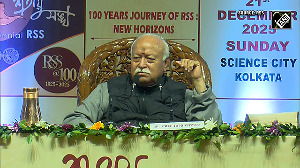There is yet another commission report now. The National Commission for Enterprises in the Unorganised Sector has produced a Social Security for Unorganised Sectors report, submitted in May 2006.
Did you know that an anagram for "UPA government" is "repugnant move"? Not surprisingly, this government has been associated with several repugnant moves and this social security idea is no different.
Not that there is anything repugnant about the social security goal, although alternative definitions of social security are possible. Inadequate access to economic opportunities and physical and social infrastructure can constrain social security, defined in a broad sense. In a narrow sense, social security may mean disability, health and life insurance, and old-age pensions.
No one objects to the idea of these being available to the Indian working population, including the unorganised sector. However, different notions of the unorganised sector are possible.
The most common is the Factories Act kind of definition and others can be through excise thresholds or levels of investment in plant and machinery. Using these, especially the first, the percentage of working population in the organised sector is estimated at less than 8 per cent (or even less than 7 per cent). There is a further problem, because not everyone in the organised sector is employed on formal terms.
The SSUS report (using NSS data for 1999-2000) has a total workforce estimate of 396.76 million and an unorganised workforce estimate of 34.68 million (8.7 per cent). Why is it so difficult to deliver social security to unorganised workers?
Primarily an identity-card problem, aggravated by presence of migrant and casual workers. If we can lick this, most constraints will disappear. Does the SSUS report have any suggestions about how this can be done? Not really, except for a blind belief in additional government bureaucracy through a National Social Security Board and Secretariat, state-level Social Security Boards and Secretariats and Workers' Facilitation Centres administered by panchayats and urban local bodies.
Now you know where the expenditure of 0.2 per cent of GDP in 2006-07, and 0.48 per cent of GDP in 2010-11 will disappear, towards administrative costs (plus some leakage).
Here is a quote. "The Draft Bill (Unorganised Workers' Social Security Bill, 2006) has suggested up to 5 per cent of the total contribution as administrative expenses This is considered as too low going by the experience of some of the welfare funds. Initially, the costs are likely to be higher as there will be set up costs for the national board as well as the various state boards.
"In addition, provision for giving grants to the proposed Workers Facilitation Centres will have to be taken into account. As such, a review of the ceiling for administrative expenses may be undertaken at the end of the third or fourth year of the scheme."
There are two tracks for benefits (health and maternity insurance, life insurance, old-age pensions, provident fund), depending on whether you are APL (above the poverty line) or below the poverty line (BPL).
The worker, the employer and the government each pays one rupee a day towards the scheme. If there is no identified employer (83 per cent of cases), the government pays the employer's contribution. If the worker is BPL, the government pays the worker's contribution.
The government means the Central and state governments, in a 3:1 ratio. Where does the government get the money? Through a "social security tax", where else? Insurance is intended for BPL workers. APL workers get old-age security through a provident fund, with unemployment insurance thrown in.
It, thus, becomes critical to decide criteria for BPL identification. Clearly, NSS surveys won't work. Will we use the 17 criteria now pushed by Planning Commission? The SSUS report, with the entire expertise of the NCEUS thrown in, ducks the issue. BPL identification is exogenous to the system, it is a political issue. Even if this is ostensibly meant for poor households, it will have universal coverage.
This is important because all insurance schemes and Ponzi schemes require outflows by claimants to be matched by premium inflows from non-claimants, despite the social security tax.
To have financial viability for BPL, you need to broad-base inclusion of APL and you do this by effectively guaranteeing a 10 per cent return on the provident fund. "However, the mutual fund organisation will not be in a position to guarantee a minimum return as per the regulations of the Securities and Exchange Board of India.
However, the experience of the past several years suggests that the annual return has been well above 10 per cent." Do you get the feeling there is a pre-reform mindset floating around? Certainly. But isn't that what the UPA government is about? Do you get the feeling this will be implemented, not for the rural poor, but for urban votes? Certainly.
But isn't that what the UPA government is about? Economists (and mathematicians) are very fond of the expression optimisation, implying doing one's best given the constraints. Optimisation and optimism have the same root.
We have a word called pessimism. So why have economists never thought of the expression pessimisation, implying doing one's worst given the constraints? That should be the UPA's slogan.





